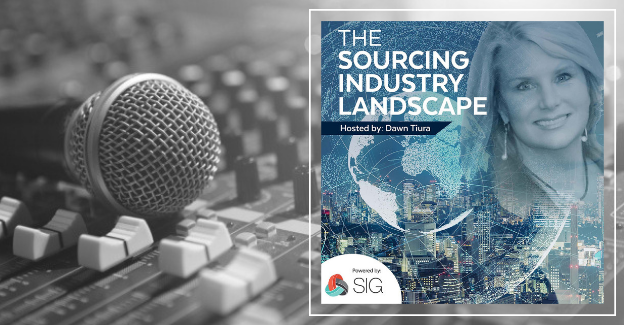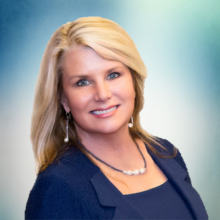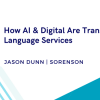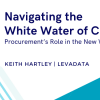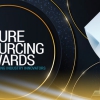Dawn Tiura: Hello folks, this is Dawn Tiura from Sourcing Industry Group, and I want to welcome you back. Today, we have the pleasure of talking to the VSP Global sourcing team finalists, and their project is called ‘Spend It Like It's Yours Project’. And Greg Tennyson is the lead over at VSP, so Greg, can I have you introduce your team?
Greg Tennyson: Sure, Greg Tennyson. With me today, I've got Nathan Haydn-Myer. Nathan heads up our Procurement Ops team as well as Insights and Branding. Dennis Kaufman heads up Sourcing, and Sid Ramesh, or Siddharth Ramesh, is one of our Senior Commodity Managers/Senior Contributors as far as the savings and the value that we bring back to the business.
Dawn Tiura: Good. So, I know the team created Spend It Like It's Yours initiative also known as SILIY, Silly, but the goal was to roll out a new thought process in the company—but what really caught hold was the conscious role out of the campaign through the use of a big purple, hairy mascot named Moola. Can you tell me about Moola?
Nathan Haydn-Myer: Yes. So, Moola is kind of the brain child of our marketing group and really they were looking for this icon that could be a big reminder for people to save money, right? And, if they're going to spend money, to spend it in a way that makes sense for the business. So, Moola is about a six-foot-six tall, purple, hairy monster who has been featured in this series of video vignettes that show his progress from a really poor corporate citizen, in terms of spend, to becoming one of the more efficient spenders of the company.
Dawn Tiura: So, you actually have a Moola? You have a physical Moola.
Nathan Haydn-Myer: We do have a physical Moola, and I have been known from time to time to play Moola.
Dawn Tiura: Is Moola gonna come to the awards program with you?
Nathan Haydn-Myer: I hope not.
Dawn Tiura: I would love to meet Moola in person.
Nathan Haydn-Myer: It gets hot in Moola.
Dawn Tiura: I bet it does. We'll get you a fan. So, tell me about the initiative and why do you think this is really what resonated with the company, because it sounds like it was very successful.
Sid Ramesh: Yeah, sure. So, to give a little background, about five years back, our VSP Senior Leadership recognized the need to do operational excellence, and through one of those initiatives was to centralize procurement. We had a very decentralized practical purchasing function back then. And then through the last five years, as we have been on this journey, to not only centralize procurement but also deliver value to our stakeholders and become a trusted advisor, we recognized the need to implement this huge change would be very beneficial if we had somebody like Moola. And our marketing groups helped put together all the information that we can use Moola to help drive and influence this change, and I think that's been a huge success factor. In terms of just getting buy in from the general masses here at VSP, as well as with all of our different business partners, and emphasizing the importance of Spending It Like It's Yours.
Dawn Tiura: I like that. So, you said also that you to do some silo busting to truly understand the risks for this project strategy. Can you tell me a little bit about that?
Nathan Haydn-Myer: Yeah. With the silos, VSP Global is made up of five different lines of business. And each, while working towards the common goal, each have their own focus of expertise, let's say. So, to get those individual lines of business to congregate around this one mission: truly purchasing efficiently, making the right purchases at the right time, getting the best value from the purchases, was different.
Nathan Haydn-Myer: Part of what created that difficulty with those groups, is each of those teams values things differently. Some might look for cost savings, while others are looking for the best value for the dollars they've spent. So, when we were this launching this program and trying to align it across all these lines of business, we had to deal with these conflicting objectives and priorities. And I think the key to that success was generating small wins within each line of business.
Nathan Haydn-Myer: So, we would generate small wins, we would truly seek to understand what was valuable for that line of business, and as we built on those wins, we could start to translate those wins to the other lines of business. We could show how a cost-savings initiative could potentially bring more value than let's say, just keeping the highest quality product, for example. As we had those wins and we were able to leverage those wins across the lines of business, the lines of business began to see the true value of the overall program and buy in deeper.
Dawn Tiura: That's fantastic. So, how many years has this been underway?
Sid Ramesh: Since 2013, so about five years. And it’s a journey.
Dawn Tiura: Do you still see people that are coming on board, or do you think everyone's there already?
Sid Ramesh: Oh yes. So, I would say from a company-wide adoption perspective, we are about eighty to eighty-three percent. There are still pockets out there that are still new. And in terms of exploring how procurement can help them, we continually try to go out and seek partners and see if they can get them on board. Of course, you know, as Nathan mentioned, there's all these different lines of business, different divisions and groups. And so, there is a lot of idiosyncrasies when you deal with a number of these diverse groups. As I said, it's a journey, and we continue to evolve and get as many people on board the procurement train.
Dawn Tiura: That's fantastic. So, I like how they said things were handled originally. Spend was disjointed, siloed, and quote unquote, selfish. And I think that's a very interesting term to put on spend for a company. Can you tell me where was it selfish?
Nathan Haydn-Myer: So, going back to the five lines of business and each having their own goals, I'll pick on marketing probably because I have a background in marketing, so it's easier for me to do. You know, marketing's goal is to get the message out and get into as many people as possible.
Dawn Tiura: Right.
Nathan Haydn-Myer: And so, in cases like that, the marketer's idea to spend is: How do I spend as much money as I can to get this message as far flying as I can get it? When in reality, what SILIY tried to do was, let's look more at the effectiveness of the spend. Right? Are you getting the impressions that you want for the spend? Or, are you just throwing money at something that could be a money pit? It was really drawn on those intentions to think about the effective use of the dollar spent, and what the outcome of what those dollars were.
Dawn Tiura: You're right. If you spend it like it's yours, and it was your money, you would be very conscious of the impact of the money you're spending. That's a great one to call attention to. I appreciate that. What do you think is next for this team?
Sid Ramesh: We have a number of initiatives lined up. As I mentioned, we continue to partner and seek engagement from the different business areas. Obviously, this is not a one-time success, we want to make sure that our program is sustainable. And innovation helps drive savings and value to our business partners. We continue to deliver road shows, where we partner with all the different business partners and help engage and understand their requirements and expectations, as well our promise and commitment to help deliver value. Nathan's probably also going to talk about the prior performance management program that we have up and running.
Dawn Tiura: Very good.
Nathan Haydn-Myer: So, it's onward and upward. Right? We've taken the wins that we've generated from SILIY, and we've really leveraged those to become the trusted advisor of the business. That's everything from budgeting, right now it's budget season so we're helping our stakeholders better inform their budget choices, to making the best purchases in the future. But those wins have allowed us to expand in other ways, such as our contract life cycle management project, which is trying to standardize conscious life cycle management across the company. As well as the supplier management program that's mentioned, we're implementing an enterprise wide supplier management program to continue to leverage this accessibility, and to continue to build innovations for our partners.
Dawn Tiura: That's fantastic. I'd love to hear more about that program on the next podcast. So, you guys have some tough competition for the Future of Sourcing Awards, but I wish you all the best of luck and hopefully all of you, and Moola, will be joining us in October.
Sid Ramesh: Thank you.
Nathan Haydn-Myer: Thank you, Dawn.
Dawn Tiura: Well, thanks to all of you, and this is VSP Global’s Spend It Like It's Yours initiative—is up for the Future of Sourcing Awards. So, thank you guys for joining us. And please join us for another podcast very soon.
Nathan Haydn-Myer: Will do. Thank you, Dawn.
Sid Ramesh: Thank you.
Dawn Tiura: That was VSP with Spend It Like It’s Yours, and up next on the podcast is GEP with their digital procurement transformation for university system.
Dawn Tiura: Welcome to the podcast series. Today, we're going to have a sourcing team finalists, and it's GEP. It's digital procurement transformation for a university system. So, I wanna welcome you guys to the podcast.
Paul: Thank you, Dawn. It's a pleasure to be here.
Dawn Tiura: So, I have Michelle and Paul from the team—some of the team members couldn't make it. But I know that you guys can tell about this transformational story. So, tell me, what was the problem you were originally going out to solve with your client?
Michelle: The organization is made of up different entities who found that they were having to pay multiple license fees, multiple implementation fees, and so on and so forth, for different software instances. But, they wanted to collaborate and take advantage of economies of scale. The software they were using not only limited what they could do, but how they could work together. In GEP, they found a vendor who can enable them to work on their terms with a software platform that gave them the best functional solutions for sourcing. But it also allowed them to work across a single instance and still maintain organizational identity by business units.
Dawn Tiura: And that's really important for university systems, isn't it?
Michelle: Absolutely. Especially considering the amount of business units and the amount of instances they had to work across. It was definitely something that was important to them, and they found it within our software.
Dawn Tiura: That's great. So now tell me, why do you think that this change and your success is going to be sustainable over time?
Paul: Well, what enterprises need today is not only the functionality in software, but they actually need to be able to do more. Particularly in procurement, they need to increase their cadence, they need to get greater savings, greater visibility of what's going on, and the ability to continue to innovate in order to remain highly relevant within the organization. Within a university system where there are so many different organizations who are trying to work together, they don't want to be hampered by the limitations of technology. As Michelle said, we found that our customer was frustrated by the fact that they wanted to collaborate, they wanted to pull resources and buying power, but the software they had wasn't allowing them to do it. So, the software implementations in the past have basically locked the customer into a way of working that becomes fixed for the duration of them using that software.
Paul: What we tried to do is to ensure that using our SMART by GEP platform, they can continue to transform their procurement practice in a way that suits them. The sustainability that they have is delivered through flexibility. Not only flexibility of the software working according to how they change over time, but their own flexibility of how they want to adapt to changes in their environment. Environment changes in government funding, for example, changes in the political structures that they're working with.
Dawn Tiura: That makes sense. This implementation took about how much time?
Michelle: It took almost about a year from start to finish.
Dawn Tiura: And do you think that they've got additional successes? If we check in next year, do you think this program can continue to grow?
Michelle: Absolutely, yes. I think that if we check in next year. They were already in talks about ways that we're looking to help improve their business processes and working collaboration on ways that we can even improve our tool based on what we're learning as we've been going through the implementation and post-implementation with their team.
Paul: And they've become an object lesson, actually, for how organizations of their scale should respond to this kind of project. There's been a great political backing within the university system for this project because they recognize the need for transformation. And even though they are made up of many campuses with their own political governance structures, with their own particular aims in mind, they have found a way to settle any differences, to find a common framework of working together, which is a great object lesson for large organizations who don't have the luxury if you like of a certain central control in procurement. And they have to include all of the various stakeholders, all the various partners, so it's a very good case for us to then take on into other organizations and say, "Here are some best practices of how you get started, but of how you continue to innovate and drive things to greater results in the future."
Dawn Tiura: Well, Paul, I was just going to ask, what do you think makes this such an incredible nomination… I think you just told me, because I know universities have lots of political nuances by campus, by school, everything else. Is that what you think is what made this thing rise to the top and become such an incredible nomination?
Paul: Well, it is that but it's also in these people we've found a partner who understands that transformation in procurement doesn't come from switching to a new software system, but from having that political will, having the enthusiasm and the mindset necessary to take a big step forward. So, those enterprises we see as being most successful are those who understand that transformation is a whole system result. It has to be people, and it has to be process, and it has to be structure, and it has to be change management, and technology because technology is where it all happens at first. Each part is equally important and what this project has shown clearly is that the right approach to stakeholder engagement and process reengineering allows you to get value out of the new software. If you just do the software bit, nothing else changes. And so that's what makes us feel very good about this particular project is that the customer already came to us with this idea that we know we have to work across the whole gamut of influences, the whole gamut of factors which affect the way the operation works.
Dawn Tiura: I'd love for you guys to do a white paper on this. I think a lot of people can learn from it. So, if you were going to give, I'm assuming other companies could follow suit. So this is something that's repeatable in other industries, is that true?
Paul: Absolutely. Michelle, do you want to expand on that a bit?
Michelle: Yes, so absolutely. I think that what can other companies really take from this and, as Paul mentioned before, the best business practices that we can share based on the fact of these other companies bringing to the sector. Uprooting your software is not going to just deliver procurement transformation. Our experience has shown us time and time again that, yes, you have to use the right software, but you also have to deploy it in the right way so we can take our experiences and our successes from this project and basically just share it with all the other companies.
Paul: That's right. Procurement transformation comes from people being more effective than they were before in a significant way. Not just ongoing process improvement, but doing more sourcing, getting better results as a quantum jump compared to the past. Of course, software can be a barrier to that as we've found our customers have experienced—and this customer experienced in the past—if you don't synthesize people with the technology and with the process, you're not necessarily going to get any better results after a big investment in technology. It's a holistic problem, so it's a holistic solution that you need.
Dawn Tiura: I'm really impressed with your nomination and the fact you were very quickly named a finalist. I hate to tell you you're also competing against another GEP team, but that speaks volumes for GEP. I just want to wish you guys the best of luck. I'm hoping that you will be coming on stage, and I'll be handing you an award. But, even if you don't win the final, final, final, you guys did an amazing job. So, congratulations on your great successes.
Paul: Thank you very much.
Michelle: Thank you very much, we appreciate that.
Dawn Tiura: Thank you.


